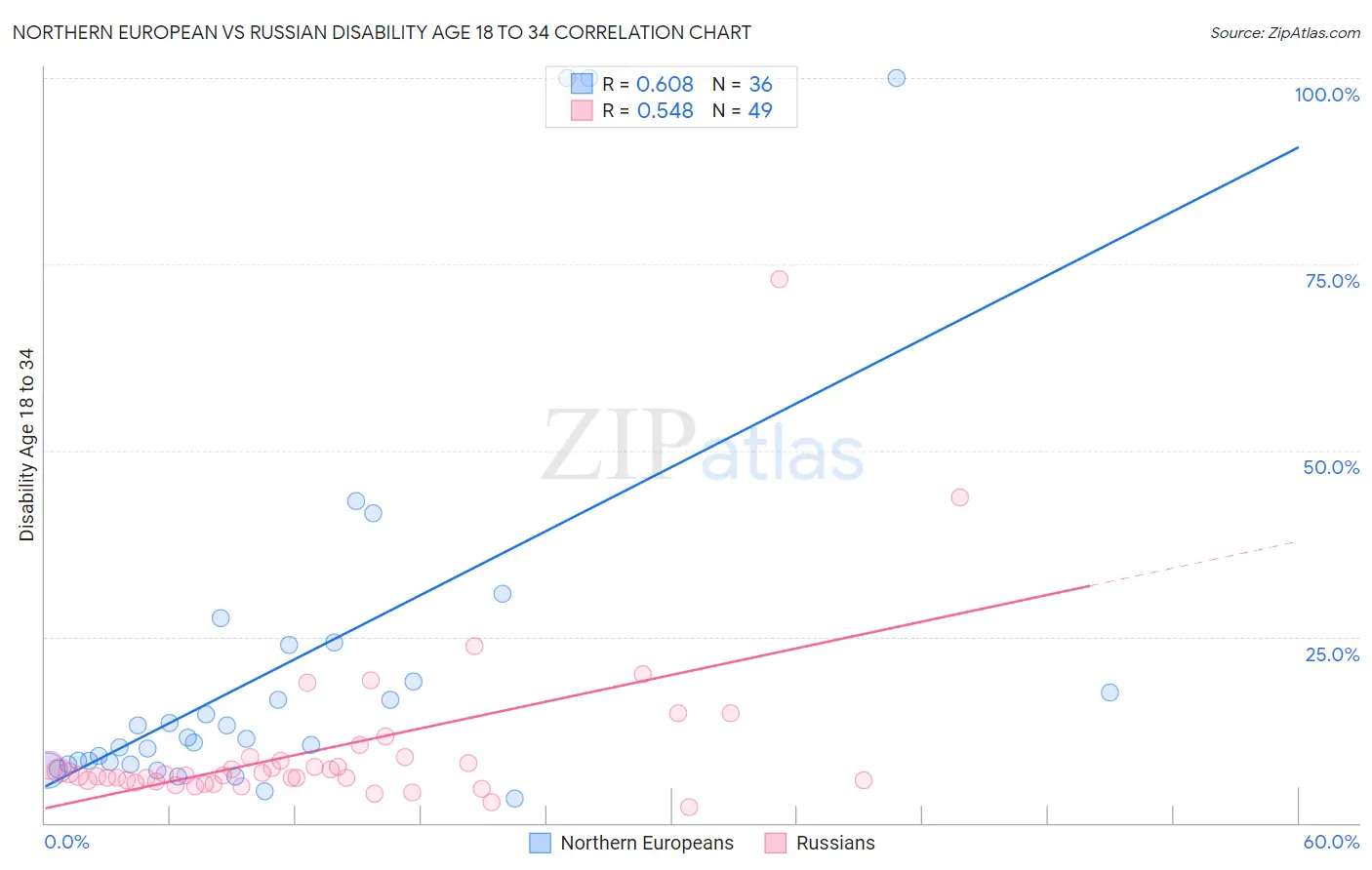Northern European vs Russian Disability Age 18 to 34
COMPARE
Northern European
Russian
Disability Age 18 to 34
Disability Age 18 to 34 Comparison
Northern Europeans
Russians
7.3%
DISABILITY AGE 18 TO 34
0.2/ 100
METRIC RATING
261st/ 347
METRIC RANK
6.5%
DISABILITY AGE 18 TO 34
60.2/ 100
METRIC RATING
169th/ 347
METRIC RANK
Northern European vs Russian Disability Age 18 to 34 Correlation Chart
The statistical analysis conducted on geographies consisting of 404,691,388 people shows a significant positive correlation between the proportion of Northern Europeans and percentage of population with a disability between the ages 18 and 35 in the United States with a correlation coefficient (R) of 0.608 and weighted average of 7.3%. Similarly, the statistical analysis conducted on geographies consisting of 509,184,365 people shows a substantial positive correlation between the proportion of Russians and percentage of population with a disability between the ages 18 and 35 in the United States with a correlation coefficient (R) of 0.548 and weighted average of 6.5%, a difference of 11.5%.

Disability Age 18 to 34 Correlation Summary
| Measurement | Northern European | Russian |
| Minimum | 3.3% | 2.1% |
| Maximum | 100.0% | 72.9% |
| Range | 96.7% | 70.8% |
| Mean | 21.4% | 10.0% |
| Median | 11.4% | 6.4% |
| Interquartile 25% (IQ1) | 8.0% | 5.7% |
| Interquartile 75% (IQ3) | 21.4% | 8.6% |
| Interquartile Range (IQR) | 13.4% | 2.9% |
| Standard Deviation (Sample) | 25.8% | 11.4% |
| Standard Deviation (Population) | 25.4% | 11.3% |
Similar Demographics by Disability Age 18 to 34
Demographics Similar to Northern Europeans by Disability Age 18 to 34
In terms of disability age 18 to 34, the demographic groups most similar to Northern Europeans are Canadian (7.3%, a difference of 0.030%), Tohono O'odham (7.3%, a difference of 0.17%), Somali (7.3%, a difference of 0.23%), Immigrants from Micronesia (7.3%, a difference of 0.30%), and British (7.3%, a difference of 0.32%).
| Demographics | Rating | Rank | Disability Age 18 to 34 |
| Indonesians | 0.4 /100 | #254 | Tragic 7.2% |
| Immigrants | Germany | 0.4 /100 | #255 | Tragic 7.2% |
| Immigrants | Laos | 0.4 /100 | #256 | Tragic 7.2% |
| Czechs | 0.3 /100 | #257 | Tragic 7.2% |
| Immigrants | Micronesia | 0.3 /100 | #258 | Tragic 7.3% |
| Somalis | 0.2 /100 | #259 | Tragic 7.3% |
| Tohono O'odham | 0.2 /100 | #260 | Tragic 7.3% |
| Northern Europeans | 0.2 /100 | #261 | Tragic 7.3% |
| Canadians | 0.2 /100 | #262 | Tragic 7.3% |
| British | 0.2 /100 | #263 | Tragic 7.3% |
| Bermudans | 0.1 /100 | #264 | Tragic 7.3% |
| Slovenes | 0.1 /100 | #265 | Tragic 7.3% |
| German Russians | 0.1 /100 | #266 | Tragic 7.4% |
| Bangladeshis | 0.1 /100 | #267 | Tragic 7.4% |
| Portuguese | 0.1 /100 | #268 | Tragic 7.4% |
Demographics Similar to Russians by Disability Age 18 to 34
In terms of disability age 18 to 34, the demographic groups most similar to Russians are Immigrants from Bahamas (6.6%, a difference of 0.17%), Immigrants from Moldova (6.5%, a difference of 0.21%), Immigrants from Northern Europe (6.5%, a difference of 0.29%), Bahamian (6.6%, a difference of 0.34%), and Eastern European (6.5%, a difference of 0.37%).
| Demographics | Rating | Rank | Disability Age 18 to 34 |
| South Africans | 71.7 /100 | #162 | Good 6.5% |
| Immigrants | Denmark | 71.7 /100 | #163 | Good 6.5% |
| Immigrants | Nigeria | 70.4 /100 | #164 | Good 6.5% |
| Immigrants | Hungary | 69.6 /100 | #165 | Good 6.5% |
| Eastern Europeans | 65.1 /100 | #166 | Good 6.5% |
| Immigrants | Northern Europe | 64.1 /100 | #167 | Good 6.5% |
| Immigrants | Moldova | 63.1 /100 | #168 | Good 6.5% |
| Russians | 60.2 /100 | #169 | Good 6.5% |
| Immigrants | Bahamas | 57.9 /100 | #170 | Average 6.6% |
| Bahamians | 55.5 /100 | #171 | Average 6.6% |
| Ghanaians | 54.7 /100 | #172 | Average 6.6% |
| Immigrants | Mexico | 54.1 /100 | #173 | Average 6.6% |
| Native Hawaiians | 50.0 /100 | #174 | Average 6.6% |
| Immigrants | Cambodia | 46.5 /100 | #175 | Average 6.6% |
| Immigrants | Africa | 45.9 /100 | #176 | Average 6.6% |